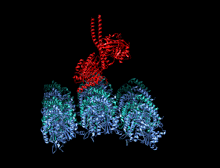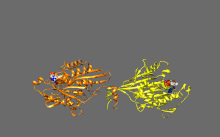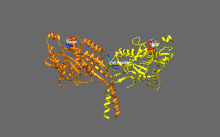Kinesin


A kinesin is a protein belonging to a class of
Discovery
The first kinesins to be discovered were microtubule-based anterograde intracellular transport motors[2] in 1985, based on their motility in cytoplasm extruded from the giant axon of the squid.[3]
The founding member of this superfamily, kinesin-1, was isolated as a heterotetrameric fast axonal organelle transport motor consisting of four parts: two identical motor subunits (called Kinesin Heavy Chain (KHC) molecules) and two other molecules each known as a Kinesin Light Chain (KLC). These were discovered via microtubule affinity purification from neuronal cell extracts.[4] Subsequently, a different, heterotrimeric plus-end-directed MT-based motor named kinesin-2, consisting of two distinct KHC-related motor subunits and an accessory "KAP" subunit, was purified from echinoderm egg/embryo extracts[5] and is best known for its role in transporting protein complexes (intraflagellar transport particles) along axonemes during ciliogenesis.[6] Molecular genetic and genomic approaches have led to the recognition that the kinesins form a diverse superfamily of motors that are responsible for multiple intracellular motility events in eukaryotic cells.[7][8][9][10] For example, the genomes of mammals encode more than 40 kinesin proteins,[11] organized into at least 14 families named kinesin-1 through kinesin-14.[12]
Structure
Overall structure
Members of the kinesin superfamily vary in shape but the prototypical kinesin-1 motor consists of two Kinesin Heavy Chain (KHC) molecules which form a protein dimer (molecule pair) that binds two light chains (KLCs), which are unique for different cargos.
The heavy chain of kinesin-1 comprises a globular head (the motor domain) at the amino terminal end connected via a short, flexible neck linker to the stalk – a long, central alpha-helical
Kinesin motor domain
| Kinesin motor domain | |||||||||
|---|---|---|---|---|---|---|---|---|---|
| CDD | cd00106 | ||||||||
| |||||||||
The head is the signature of kinesin and its amino acid sequence is well conserved among various kinesins. Each head has two separate


Basic kinesin regulation
Kinesins tend to have low basal enzymatic activity which becomes significant when microtubule-activated.
Cargo transport
In the cell, small molecules, such as gases and
There is significant evidence that cargoes in-vivo are transported by multiple motors.[25][26][27][28]
Direction of motion
Motor proteins travel in a specific direction along a microtubule. Microtubules are polar; meaning, the heads only bind to the microtubule in one orientation, while ATP binding gives each step its direction through a process known as neck linker zippering.[29]
It has been previously known that kinesin move cargo towards the plus (+) end of a microtubule, also known as anterograde transport/orthograde transport.[30] However, it has been recently discovered that in budding yeast cells kinesin Cin8 (a member of the Kinesin-5 family) can move toward the minus end as well, or retrograde transport. This means, these unique yeast kinesin homotetramers have the novel ability to move bi-directionally.[31][32][33] Kinesin, so far, has only been shown to move toward the minus end when in a group, with motors sliding in the antiparallel direction in an attempt to separate microtubules.[34] This dual directionality has been observed in identical conditions where free Cin8 molecules move towards the minus end, but cross-linking Cin8 move toward the plus ends of each cross-linked microtubule. One specific study tested the speed at which Cin8 motors moved, their results yielded a range of about 25-55 nm/s, in the direction of the spindle poles.[35] On an individual basis it has been found that by varying ionic conditions Cin8 motors can become as fast as 380 nm/s.[35] It is suggested that the bidirectionality of yeast kinesin-5 motors such as Cin8 and Cut7 is a result of coupling with other Cin8 motors and helps to fulfill the role of dynein in budding yeast, as opposed to the human homologue of these motors, the plus directed Eg5.[36] This discovery in kinesin-14 family proteins (such as Drosophila melanogaster NCD, budding yeast KAR3, and Arabidopsis thaliana ATK5) allows kinesin to walk in the opposite direction, toward microtubule minus end.[37] This is not typical of kinesin, rather, an exception to the normal direction of movement.

Another type of motor protein, known as dyneins, move towards the minus end of the microtubule. Thus, they transport cargo from the periphery of the cell towards the center. An example of this would be transport occurring from the terminal boutons of a neuronal axon to the cell body (soma). This is known as retrograde transport.
Mechanism of movement
In 2023 direct visualization of kinesin "walking" along a microtubule in real-time was reported.[38] In a "hand-over-hand" mechanism, the kinesin heads step past one another, alternating the lead position. Thus in each step the leading head becomes the trailing head, while the trailing head becomes the leading head.
- This cycle begins with the trailing head releasing inorganic phosphate (Pi) derived from the hydrolysis of ATP.
- The trailing head detaches from the microtubule and rotates into its rightward displaced unbound state.
- The leading head binds ATP which causes the neck linker to dock to it, which moves the trailing head around the leading head into a position further along the microtubule in the direction of travel. The trailing head remains unbound.
- The ATP in the leading head is hydrolyzed.
- The trailing head releases its ADP and the binds to the microtubule becoming the leading head.[39][40][41][42][43][44]
Theoretical modeling
A number of theoretical models of the molecular motor protein kinesin have been proposed.[45][46][47] Many challenges are encountered in theoretical investigations given the remaining uncertainties about the roles of protein structures, the precise way energy from ATP is transformed into mechanical work, and the roles played by thermal fluctuations. This is a rather active area of research. There is a need especially for approaches which better make a link with the molecular architecture of the protein and data obtained from experimental investigations.
The single-molecule dynamics are already well described[48] but it seems that these nano scale machines typically work in large teams.
Single-molecule dynamics are based on the distinct chemical states of the motor and observations about its mechanical steps.[49] For small concentrations of adenosine diphosphate, the motor's behaviour is governed by the competition of two chemomechanical motor cycles which determine the motor's stall force. A third cycle becomes important for large ADP concentrations.[49] Models with a single cycle have been discussed too. Seiferth et al. demonstrated how quantities such as the velocity or the entropy production of a motor change when adjacent states are merged in a multi-cyclic model until eventually the number of cycles is reduced.[50]
Recent experimental research has shown that kinesins, while moving along microtubules, interact with each other,[51][52] the interactions being short range and weak attractive (1.6±0.5 KBT). One model that has been developed takes into account these particle interactions,[48] where the dynamic rates change accordingly with the energy of interaction. If the energy is positive the rate of creating bonds (q) will be higher while the rate of breaking bonds (r) will be lower. One can understand that the rates of entrance and exit in the microtubule will be changed as well by the energy (See figure 1 in reference 30). If the second site is occupied the rate of entrance will be α*q and if the last but one site is occupied the rate of exit will be β*r. This theoretical approach agrees with the results of Monte Carlo simulations for this model, especially for the limiting case of very large negative energy. The normal totally asymmetric simple exclusion process for (or TASEP) results can be recovered from this model making the energy equal to zero.
Mitosis
In recent years, it has been found that microtubule-based molecular motors (including a number of kinesins) have a role in mitosis (cell division). Kinesins are important for proper spindle length and are involved in sliding microtubules apart within the spindle during prometaphase and metaphase, as well as depolymerizing microtubule minus ends at centrosomes during anaphase.[53] Specifically, Kinesin-5 family proteins act within the spindle to slide microtubules apart, while the Kinesin 13 family act to depolymerize microtubules.
Kinesin superfamily
Human kinesin superfamily members include the following proteins, which in the standardized nomenclature developed by the community of kinesin researchers, are organized into 14 families named kinesin-1 through kinesin-14:[12]
- 1A – KIF1A, 1B – KIF1B, 1C – KIF1C = kinesin-3
- 2A – KIF2A, 2C – KIF2C = kinesin-13
- 3B – KIF3B or 3C – KIF3C ,3A - KIF3A = kinesin-2
- 4A – KIF4A, 4B – KIF4B = kinesin-4
- 5A – KIF5A, 5B – KIF5B, 5C – KIF5C = kinesin-1
- 6 – KIF6 = kinesin-9
- 7 – KIF7 = kinesin-4
- 9 – KIF9 = kinesin-9
- 11 – KIF11= kinesin-5
- 12 – KIF12 = kinesin-12
- 13A – KIF13A, 13B – KIF13B = kinesin-3
- 14 – KIF14 = kinesin-3
- 15 – KIF15 = kinesin-12
- 16B – KIF16B = kinesin-3
- 17 – KIF17 = kinesin-2
- 18A – KIF18A, 18B – KIF18B = kinesin-8
- 19 – KIF19 = kinesin-8
- 20A – KIF20A, 20B – KIF20B = kinesin-6
- 21A – KIF21A, 21B – KIF21B = kinesin-4
- 22 – KIF22 = kinesin-10
- 23 – KIF23 = kinesin-6
- 24 – KIF24 = kinesin-13
- 25 – KIF25 = kinesin-14
- 26A – KIF26A, 26B – KIF26B = kinesin-11
- 27 – KIF27 = kinesin-4
- C1 – KIFC1, C2 – KIFC2, C3 – KIFC3 = kinesin-14
kinesin-1 light chains:
kinesin-2 associated protein:
- KIFAP3(also known as KAP-1, KAP3)
See also
- Axonal transport
- Dynein
- cilia
- Kinesin 8
- Kinesin 13
- KRP
- Molecular motor
- Transport by multiple-motor proteins
References
- ^ Berg J, Tymoczko JL, Stryer L (2002). "Kinesin and Dynein Move Along Microtubules". Biochemistry. 5th Edition.
- S2CID 15100327.
- PMID 20930137.
- PMID 3926325.
- S2CID 4367715.
- S2CID 12130216.
- S2CID 44318695.
- PMID 1447303.
- S2CID 27420513.
- S2CID 19660190.
- S2CID 18129292.
- ^ PMID 15479732.
- S2CID 731898.
- PMID 8606779.
- ^ PMID 21836017.
- PMID 8506368.
- S2CID 10713993.
- PMID 31217419.
- PMID 17200414.
- PMID 30770434.
- S2CID 4363000.
- PMID 10753125.
- PMID 16844749.
- PMID 23091068.
- S2CID 8791125.
- S2CID 7540556.
- PMID 18701289.
- PMID 16287974.
- S2CID 573909.
- ^ Lodish H, Berk A, Zipursky SL, Matsudaira P, Baltimore D, Darnell J (2000). "Kinesin, Dynein, and Intracellular Transport".
{{cite journal}}: Cite journal requires|journal=(help) - S2CID 90739364.
- PMID 29117528.
- PMID 24589736.
- S2CID 90739364.
- ^ PMID 22101328.
- PMID 17173688.
- PMID 15659646.
- PMID 36893224.
- PMID 36893247.
- S2CID 251162014.
- S2CID 30529199.
- PMID 15661524.
- PMID 20160108.
- ^ Lay Summary (18 February 2010). "Life's smallest motor, cargo carrier of the cells, moves like a seesaw". PhysOrg.com. Retrieved 31 May 2013.
- S2CID 13534734.
- PMID 7787069.
- PMID 11419956.
- ^ S2CID 14002728.
- ^ PMID 17678059.
- S2CID 231652939.
- PMID 16407972.
- PMID 11580246.
- PMID 15958489.
Further reading
- Lawrence CJ, Dawe RK, Christie KR, Cleveland DW, Dawson SC, Endow SA, Goldstein LS, Goodson HV, Hirokawa N, Howard J, Malmberg RL, McIntosh JR, Miki H, Mitchison TJ, Okada Y, Reddy AS, Saxton WM, Schliwa M, Scholey JM, Vale RD, Walczak CE, Wordeman L (October 2004). "A standardized kinesin nomenclature". The Journal of Cell Biology. 167 (1): 19–22. PMID 15479732.
External links
- MBInfo - Kinesin transports cargo along microtubules
- Animated model of kinesin walking
- Ron Vale's Seminar: "Molecular Motor Proteins"
- Animation of kinesin movement ASCB image library
- Murphy, V.F. (12 May 2004). "Microtubule Based Movement". tissue.medicalengineer.co.uk. Archived from the original on 22 July 2007. Retrieved 10 December 2015.
- The Inner Life of a Cell, 3D animation featuring a Kinesin transporting a vesicle Archived 7 December 2008 at the Wayback Machine
- The Kinesin Homepage
- Kinesin at the U.S. National Library of Medicine Medical Subject Headings (MeSH)
- EC 3.6.4.4
- EC 3.6.4.5
- 3D electron microscopy structures of kinesin from the EM Data Bank(EMDB)

